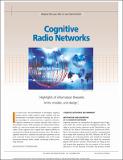| dc.contributor.author | Devroye, Natasha | |
| dc.contributor.author | Vu, Mai | |
| dc.contributor.author | Tarokh, Vahid | |
| dc.date.accessioned | 2009-03-08T19:50:47Z | |
| dc.date.issued | 2008 | |
| dc.identifier.citation | Devroye, Natasha, Mai Vu, and Vahid Tarokh. 2008. Cognitive radio networks: Highlights of information theoretic limits, models and design. IEEE Signal Processing Magazine 25(6): 12-23. | en |
| dc.identifier.issn | 1053-5888 | en |
| dc.identifier.uri | http://nrs.harvard.edu/urn-3:HUL.InstRepos:2643644 | |
| dc.description.abstract | In recent years, the development of intelligent, adaptive wireless devices called cognitive radios, together with the introduction of secondary spectrum licensing, has led to a new paradigm in communications: cognitive networks. Cognitive networks are wireless networks that consist of several types of users: often a primary user (the primary license-holder of a spectrum band) and secondary users (cognitive radios). These cognitive users employ their cognitive abilities to communicate without harming the primary users. The study of cognitive networks is relatively new and many questions are yet to be answered. In this article we highlight some of the recent information theoretic limits, models, and design of these promising networks. | en |
| dc.description.sponsorship | Engineering and Applied Sciences | en |
| dc.language.iso | en_US | en |
| dc.publisher | Institute of Electrical and Electronic Engineers | en |
| dc.relation.isversionof | http://dx.doi.org/10.1109/MSP.2008.929286 | en |
| dash.license | OAP | |
| dc.title | Cognitive Radio Networks: Highlights of Information Theoretic Limits, Models and Design | en |
| dc.relation.journal | IEEE Signal Processing Magazine | en |
| dash.depositing.author | Tarokh, Vahid | |
| dc.identifier.doi | 10.1109/MSP.2008.929286 | * |
| dash.contributor.affiliated | Tarokh, Vahid | |


